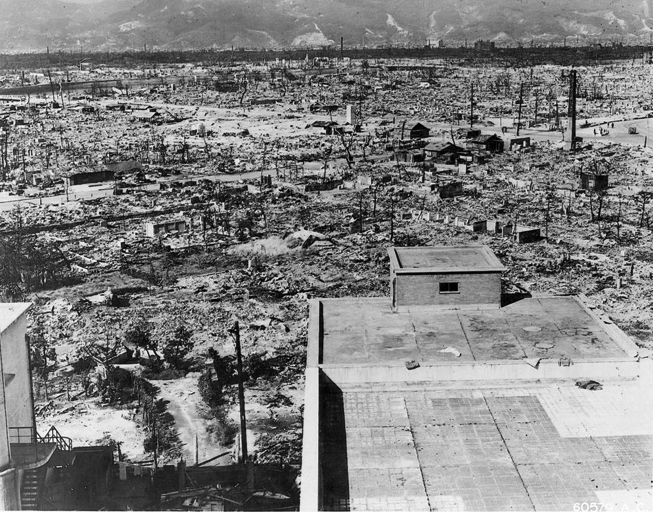What Happens When a Nuclear Weapon Explodes?

The greatest immediate damage from a nuclear weapon comes from a blast wave and thermal radiation. It’s not really that different from how other bombs work. The big difference is the magnitude of the effect. In addition to the extent of the effect, nuclear weapons cause great damage through radiation.
The blast wave
When a nuclear weapon explodes, an intense flash of light is visible, as if from a giant bolt of lightning. It blinds and burns everything within a certain radius. There is no chance to take shelter from this thermal radiation if you have not been warned.
Everything in the place where the bomb explodes crumbles and burns. What remains is smoke, gases and small particles that rise into the air and a mushroom-like cloud is formed. Shortly afterwards, the shockwave arrives. The shockwave is so violent that it smashes houses and crushes people many kilometers away.
The enormous shockwave can reach a speed of several hundred kilometers/hour. People who are near the explosion site can be killed by the shockwave alone. At longer distances, the pressure causes damage inside the body such as lung damage, ruptured eardrums and internal bleeding. But the pressure wave will above all cause indirect damage.
Buildings collapse and bury people. People will be thrown at objects. Materials such as shards of glass, bricks, concrete and wood will be thrown around and cause extensive damage to people.
The blast wave and thermal radiation are the factors that immediately cause the most injuries and deaths in a nuclear explosion. In Nagasaki, it is estimated that 9 percent of all those who died immediately after the atomic bombing died as a result of flying shards of glass. About the same number died due to other flying material hitting people at high speed. In Hiroshima, the percentage of deaths as a result of falling and flying material must have made up 30 percent of all deaths.
Thermal radiation

The “shadow” of a ladder and a Japanese soldier after the atomic bombing of the Japanese city of Nagasaki, 1945. The soldier was 2 km from the epicentre when the heat from the explosion burnt the paint from the surface of the wall, except where it was shaded by the ladder and the victim’s body. (Photo: Authenticated News/Archive Photos/Getty Images)
Within a certain distance from the explosion site, the thermal radiation has such a high temperature that practically everything is vaporized: whole bodies are “vaporized” and obliterated. Heat moves incredibly fast and it is therefore not possible to take protection against the thermal radiation – if no warning is given. Further away from the area of fatal injury due to the thermal radiation, many people will suffer from burns.
The thermal radiation leads to direct burns on bare skin. Even burning clothing will lead to severe burns. People with burns are time- and labor-intensive to care for and therefore represent a major challenge for healthcare in the event of a nuclear explosion.
In Hiroshima, 60 percent of all immediate deaths are estimated to have been caused by burns.
The thermal radiation will set cities and forests on fire and result in firestorms. Many people will be injured and die instantly in these fires. Within these areas, even people staying in underground shelters will die from the heat, lack of oxygen, or from inhaling toxic gases, carbon monoxide or carbon dioxide, from the smoke.
The thermal radiation also causes eye damage and many people will be blinded by the nuclear explosion. Vision often returns within minutes, but the bright light can also lead to permanent damage to the eyes, such as retinal burns.
Radiation
Another major difference is that a nuclear explosion releases large amounts of radiation. A large dose of radiation can kill a person instantly. Exposure to a slightly smaller amount causes acute radiation sickness, a very serious illness that leads to slow death after days or years of suffering. Radiation can cause genetic damage which, for example, leads to children being born with deformities.
Initial radiation
Initial radiation is the radiation that comes first from a nuclear weapon detonation. It consists of gamma and neutron radiation that is emitted at the moment of explosion and lasts for a maximum of one minute. The radiation causes immediate damage to people, animals, the environment and electronics. The initial radiation rapidly decreases in intensity the further you are from the actual explosion site.
Near the explosion site, the neutron radiation is stronger than the gamma radiation, while the ratio evens out further away.
The consequences of radiation
Radiation contaminates large areas of land, making agriculture impossible for years or even decades after a nuclear explosion. The poisoning of people and their environment by radiation makes the recovery after a nuclear explosion long and painful.
Long after a nuclear explosion, radioactivity will spread both in the area around the explosion site and, depending on the weather and wind, also far away from the explosion site. It is called radioactive fallout. People can be affected by the fallout directly by being hit by the fine dust that rains down. But they can also ingest radioactive particles through food, via plants and animals that have absorbed radioactive substances.
A lethal dose of radiation can be as small as the amount of energy in the heat of a single sip of hot coffee. That is, a very small amount.
Electromagnetic Pulse (EMP)
When gamma radiation knocks electrons out of the atoms of air molecules, these electrons combine to form a strong pulse of electric current, generating an electromagnetic field. This field then propagates as a very short-lived wave: an electromagnetic pulse. EMP causes disturbances and damage in electronic equipment.
EMP is a serious threat to our modern society, since a major part of the infrastructure depends on electronics. There are numerous items that can catch and conduct electromagnetic energy, such as antennas, telephone wires, railway tracks. This energy can surge into computers and other sensitive equipment and cause damage to vital systems, like those supplying water or electricity, or telecommunications. Without these systems, our society will stop functioning. The EMP of a hydrogen bomb detonated at a high altitude could knock out all electronic systems within a very large area (e.g., all Northern Europe).
Unique destructive power
Nuclear weapons are unique in their destructive power and are in every sense a weapon of mass destruction. They release enormous amounts of energy, both in the form of blast waves, thermal radiation and radiation. These aspects of nuclear weapons introduce a whole new dimension of terror and it is important to remember that it is humans who hold the trigger. Nuclear weapons are created by humans and can also be dismantled by humans.

Hiroshima after the atomic bomb in 1945.
Sources and more information
Humanitarian impacts, ICAN Australia
No place to hide: nuclear weapons and the collapse of health care systems, International Campaign to Abolish Nuclear Weapons, February 2022




